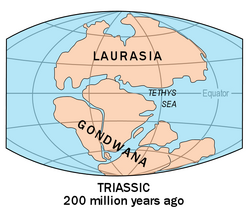
Laurasia was a supercontinent that most recently existed as a part of the split of the Pangaean supercontinent in the late Mesozoic era. It included most of the landmasses which make up today's continents of the northern hemisphere, chiefly Laurentia (most of modern North America), Baltica, Siberia, Kazakhstania, and the North China and East China Cratons.
Origin
Although Laurasia is known as a Mesozoic phenomenon, today it is believed that the same continents that formed the later Laurasia also existed as a coherent supercontinent after the breakup of Rodinia around 1 billion years ago. To avoid confusion with the Mesozoic continent, this is referred to as Proto-Laurasia. It is believed that Laurasia did not break up again before it recombined with the southern continents to form the late Precambrian supercontinent of Pannotia, which remained until the early Cambrian.
Break Up and Reformation
During the Cambrian, Laurasia was largely located in equatorial latitudes and began to break up, with North China and Siberia drifting into latitudes further north than those occupied by continents during the previous 500 million years. By the Devonian, North China was located near the Arctic Circle and it remained the northernmost land in the world during the Carboniferous Ice Age between 300 and 280 million years ago. There is no evidence, though, for any large scale Carbonifeous glaciation of the northern continents. This cold period saw the re-joining of Laurentia and Baltica with the formation of the Appalachian Mountains and the vast coal deposits which are today a mainstay of the economy of such regions as West Virginia and parts of England and Germany.
Siberia moved southwards and joined with Kazakhstania, a small continental region believed today to have been created during the Silurian by extensive volcanism. When these two continents joined together, Laurasia was nearly reformed, and by the beginning of the Triassic, the East China craton had rejoined the redeveloping Laurasia as it collided with Gondwana to form Pangaea. North China became, as it drifted southwards from near-Arctic latitudes, the last continent to join with Pangaea.
Final split
Around 200 million years ago, Laurasia divided into the continents after which it is named: Laurentia (now North America) and Eurasia (excluding India and Arabia). Most of the cratons that made up Laurasia, as can be seen, remain attached to it today, though rifting still occurs today in the region of Lake Baikal.
See also
- Alfred Wegener
- Continental drift
- Gondwana
- Laurasiatheria
- Pangaea
- Plate tectonics
- Seafloor spreading
- Supercontinent